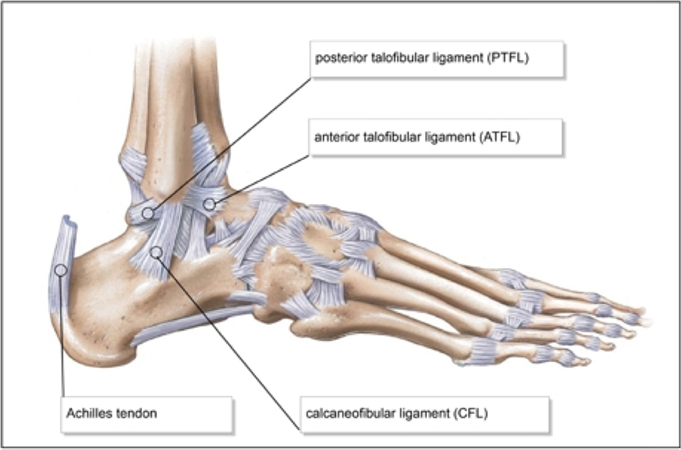Lets talk about that painful, swollen, stiff, acute ankle sprain. We have all been there at one time or another. Whether walking, running, going down the stairs, or awkwardly stepping over the curb that was higher than we thought….we step down and BOOM…..our ankle is turned the wrong direction and laying on the ground flatter than a pancake. No matter if you are younger or older, in your athletic prime or need to hit the gym a little more frequently, rolling your ankle hurts!!
Take it from someone who has rolled his ankle more times than I can remember; if left untreated, these acute ankle sprains can become a major problem. And no…its not just the acute pain that is the issue, nor the swelling of it that more closely resembles a basketball than your ankle. It’s the trauma to the ligaments, the straining of the musculature, the shifting of the lower end of your fibula (will come back to this in a minute), and most importantly: the secondary compensations we make to take pressure off this area.
And no…its not just the acute pain that is the issue, nor the swelling of it that more closely resembles a basketball than your ankle. It’s the trauma to the ligaments, the straining of the musculature, the shifting of the lower end of your fibula (will come back to this in a minute), and most importantly: the secondary compensations we make to take pressure off this area.
I preach this mantra to every patient, parent, coach, nurse, or physician I speak to. Give me an injury within the first 24-72 hours following the initial injury and I will significantly shorten down the overall time duration of the healing process. There has been a standard operating procedure for ankle sprains R.I.C.E. (Rest, Ice, Compression, and Elevation). But there is one more “I” which has been prevalent for years of treating these types of injuries…Immobilization.
Most people would tell you to not move the joint, immobilize it to take pressure off of the tissue and the joint. It’s certainly not a wrong choice, especially if there is a level of significant hypermobility noted or a fracture present. But short of that, should you keep an acute ankle sprain immobilized completely? Absolutely not!!
Mobility is the key to reducing swelling, restoring functional range of motion, and getting a patient back to more normalized walking. The typical inversion sprain (rolling your ankle inwards towards the other foot) is the most common type. Normally when this happens the main ligament injured is the Anterior Talofibular Ligament (ATFL).  When the ATFL gets strained it pull the lower part of the fibula, the outer of the two long bones of the calf, downwards and forwards. That slight shift can create major impingement on the ATFL, limiting a persons ability to dorsiflex the ankle (bring the toe and foot towards the shin). Every time they attempt this, not only is the ligament already swollen and puffed up from being sprained, but now you have a bone poking at it because its shifted closer making it more painful and harder to move.
When the ATFL gets strained it pull the lower part of the fibula, the outer of the two long bones of the calf, downwards and forwards. That slight shift can create major impingement on the ATFL, limiting a persons ability to dorsiflex the ankle (bring the toe and foot towards the shin). Every time they attempt this, not only is the ligament already swollen and puffed up from being sprained, but now you have a bone poking at it because its shifted closer making it more painful and harder to move.
But don’t worry, this is not something you need surgery for or should go into a walking boot to correct. All you need is proper joint mobilization and a simple but effective taping technique to assist with keeping the lower part of the fibula shifted back and up into the proper position to decompress the ligament and the joint line.
Now this isn’t the only type of ankle sprain and certainly isn’t the fix for them all. However, it is the most common form of ankle sprain and one that if left untreated can linger and create a wide variety of secondary complications.
Once you address the swelling, immobility, and functional limitations, it is imperative to not lose sight of the most important part: to ensure restoration of movement. With full mobility we can correct problems with how you walk and move to ensure any compensations are eliminated. From there, regaining proper strength, stability and proprioception will bring you back to full function.
The key though is early intervention. We as a society have continuously reassessed and revamped a wide variety of antiquated processes. So answer me this: Why do we still assume that orthopedic injuries will just go away on their own? Be proactive and don’t miss weeks of game time or recreation time because you thought it would just go away.
Kyle Branday, MSPT, CDN is a partner at Amity Physical Therapy and supervising therapist in the Woodbridge office. With 12 years of experience in the Woodbridge and Greater New Haven area, Kyle has prided himself on quick and effect treatment of both acute and chronic conditions ranging from orthopedic to neurological problems. Being certified in Trigger Point Dry Needling, Kyle is able to treat stubborn trigger points and referred pain. To make an appointment, call (203) 389-4593 or visit our website at www.amitypt.com
Keep up with all the latest news, articles, and key information to keep your healthy and moving for following Amity PT on Facebook, Instagram, and Twitter


